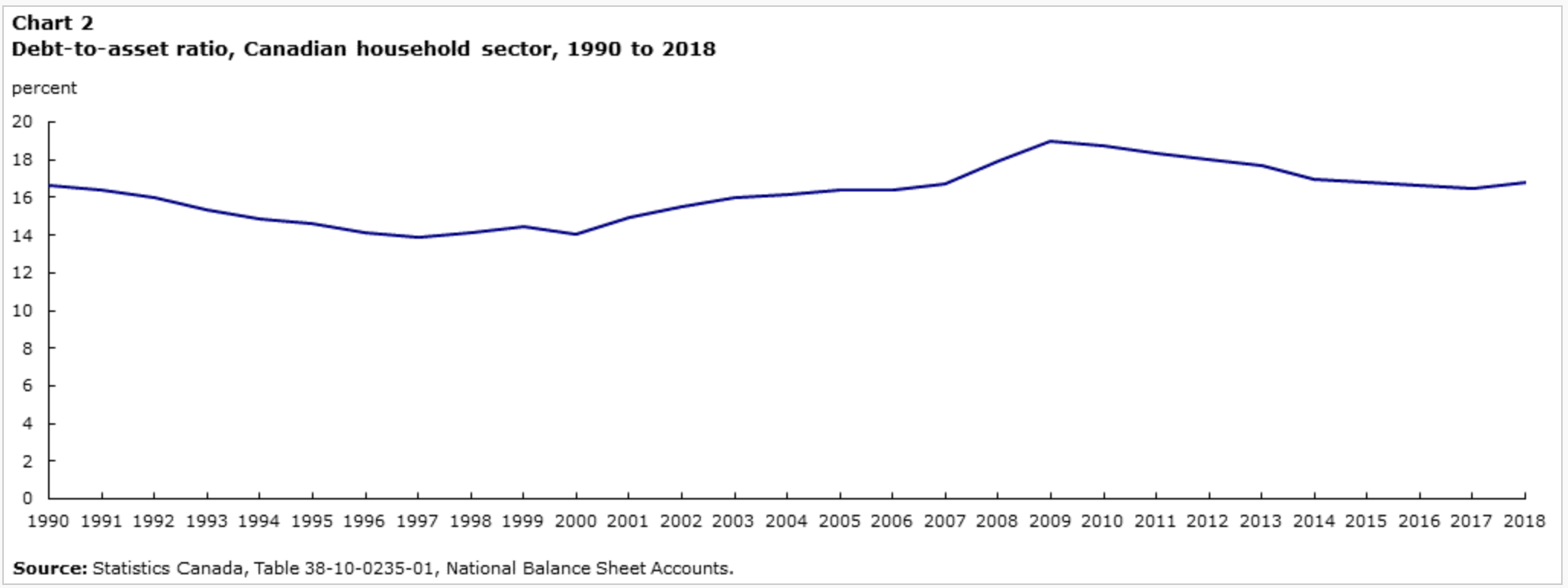…You’re older, a lone-parent, making a modest income and living in the Prairies.
That’s a sampling of insight from this new StatsCan study.
Newer lenders could find this report interesting, given they always want to know who’s most likely to miss a mortgage payment.
StatsCan’s research also downplays the highly publicized “debt-to-income ratio,” which makes news headlines every quarter. The agency writes that one’s debt-to-asset ratio is actually a much better gauge of a “family’s resilience to financial shocks” than the debt-to-income ratio.
“Families with a higher debt-to-asset ratio are more likely to report having experienced a variety of financial problems,” including missed mortgage payments, its data shows.

For people whose debt is more than half the value of their assets:
- 7% missed a mortgage payment in the prior year (versus 1.7% for those with a debt-to-asset ratio of 25% or less)
- 16% missed a non-mortgage payment (e.g., a bill, a credit card, etc.)
Overall by comparison, 4% of those with a mortgage “skipped or delayed a mortgage payment in the year preceding the survey.”
That said, actual mortgage arrears are just 0.25%, meaning only 2.5 out of 1,000 are 90+ days past due on their mortgage. This suggests that some of the folks who skipped a mortgage payment presumably used their lender’s skip-a-payment feature.
Among those most likely to miss a mortgage payment:
- 55-to-64-year-olds (8.1% missed a mortgage payment vs. 3.9% for 35-to-44-year-olds)
- Lone-parent families (9.4% missed a mortgage payment vs. 2.4% for couples with no children)
- People in the lowest quintile of income (6.8% missed a mortgage payment vs. 2.2% in the highest quintile)
- Those living in the Prairies (6.8% missed a payment vs 3.2% in Ontario)
Incidentally, if you’re an older, lone-parent borrower making modest income and living in the Prairies, don’t be surprised if you don’t get the lowest mortgage rate on offer.
 Debt-to-Income is Overhyped
Debt-to-Income is Overhyped
StatsCan concludes “…The debt-to-income ratio is not associated with…financial distress since the results are not statistically significant.”
Will newspaper editors care? Media stories on debt-to-income seem never-ending.
Yet, based on this report, the debt-to-asset ratio is the metric more people should be writing about. It’s the “more predictive indicator,” StatsCan suggests, partly because:
A) Debtors “can often sell assets to make debt payments, even if they do not have the income to make payments,” or
B) Tap into home equity lines of credit (HELOCs), if they own a home.

 log in
log in
10 Comments
I never understood the focus on debt to income. For evaluating credit worthiness, debt service costs vs income is what matters.
I agree on the importance of assets, which definitely matters to lenders. It is a lot easier for a high net worth individual to squeeze a few extra bps discount or push TDS limit on a mortgage.
I agree. The Bank of Canada refers constantly to debt-to-income but it’s such a misleading metric. Assuming the borrower is properly qualified, the only thing a high DTI means is that he/she will take longer to pay off the mortgage. That may have economic implications but its relationship with defaults can be mitigated by many other factors like equity, employment quality and credit history.
no lender is going to learn anything from this report. its survey based, not based on hard administrative data. the categories used for the debt to asset and debt to income analysis are both strange. all the risk is at higher levels for both and further disaggregation at higher levels would be more helpful. lastly. for a first time buyer, their debt is essentially their mortgage, and their asset is their home. so the debt to asset ratio is just the loan to value ratio, which we all know, the higher the LTV and greater the risk. wow. what a finding.
“no lender is going to learn anything from this report. its survey based, not based on hard administrative data.”
That’s quite an unsupported categorical statement, David, given there are 400+ prime lenders in this country. It won’t be a revelation to the vast majority, and many won’t care, and some might not even be aware of this info. But there may be some who data mine their portfolios because of such findings and/or somehow incorporate tiny bits of StatsCan’s insights into their underwriting policies/models/algorithms.
“all the risk is at higher levels for both and further disaggregation at higher levels would be more helpful.”
Agree on this.
“for a first time buyer, their debt is essentially their mortgage, and their asset is their home. so the debt to asset ratio is just the loan to value ratio, which we all know, the higher the LTV and greater the risk. wow. what a finding.”
The report is not limited to first-time buyers. Nor are all first-timers devoid of non-housing assets.
“If you’re an older, lone-parent borrower making modest income and living in the Prairies, don’t be surprised if you don’t get the lowest mortgage rate on offer.”
I completely disagree with this statement. As a former Big5 mortgage approver, this sort of type profiling never is included in rate or approval. If the borrower fits the box, they get the rate and approval. If a Lender where to profile their customer like that another Lender will come in a swoop up the deal with a better rate.
The only difference where a borrower gets a preferred rate and/or set of terms comes in the form of exceptions to a credit policy and brand loyalty (preferred pricing). Banks will always discount an extra few bps for acquisition. And brokers will buy down a rate to lock in a customer to get the finders fee.
Does Canada really have 400+ prime lenders? Doubtful.
“…this sort of type profiling never is included in rate or approval.”
Credit decisions are based largely on a lender’s internal risk rating of the customer. Such ratings are the product of complex predictive credit scoring models. If by “never” you’re claiming to know the proprietary models of all 400+ prime lenders in Canada, that’s impressive. I can comment only by anecdote from speaking with countless individual lenders over the years.
In any event, don’t confuse discrimination with risk assessment. Clearly no one is supposed to penalize a borrower just because she’s old or is a single parent. Note I say “supposed to” as I’ve seen numerous cases where older borrowers get denied for what appears to be no other reason than their age, for example, but that’s a different discussion. It’s more that such combined characteristics can be correlated with lower levels of creditworthiness (e.g., higher debt ratios, less stable finances, weaker credit, etc.) and/or higher losses given default.
As for rates, mortgage pricing is largely risk-based. The less creditworthy you are or the less liquid the collateral, for example, the fewer options you have and the higher rates you pay. Pricing is also competition based and often set locally. Take 100 borrowers in Central Butte, Saskatchewan and compare their average 5-year fixed rate (holding key credit characteristics constant) to 100 borrowers in downtown Toronto and see what you find.
As for the number of prime lenders, there are 252 credit unions and 87 banks alone (not all banks offer prime lending). Then you have trust companies, 271 caisses, mortgage finance companies and miscellaneous like ATB, life insurers and federal credit unions. I had a full list used for our rate scans that had 437 lenders (we don’t track all caisses individually), but it’s a few years old so with credit union/lender consolidation the number is a bit lower today.
Hello Spy
For someone living in rural alberta what do u suggest for getting the best rate?
Thanks
Hi John,
Step one is to compare rates in the province, which can be done here: https://www.ratespy.com/best-mortgage-rates-alberta
Step two takes a bit more work. Depending on where the property is located, lender options may be more limited. Some of the most competitive lenders (rate-wise) won’t lend in small rural towns, or towns more than X kilometres from a large population centre.
The best bet is to contact the provider you’re interested in and ask if the advertised rate applies to your address.
Good luck!
This is very interesting. I speak from my experience versus the statistics that maybe collected over time on your site.
I think the difference between Central Butte, SK and Toronto is considerable. First off, there is less mortgagors in Central Butte v Toronto. And those who are actively mortgaging property in Central Butte and the frequency will displace the average. And I would assume those getting new mortgages in Central Butte are less likely to use a broker or go outside their local market for financing. Again, skewing results.
Do you have analysis on Calgary v Toronto? I would assume they would be very similar.
Lenders price based on risk and then loyalty. In mortgage financing this is highly determined on first the borrower and secondly the property. TDS is a simple formula. A lenders exception to policy varies; whether a borrower would secure an exception beyond traditional TDS guidelines varies based on the lenders policy and tolerance for variation to policy. And what the lender will include as income or how they determine what income is used for debt servicing.
The mortgage market is high volume, relatively low risk lending and very competitive. I just don’t believe there is that type of profiling that you suggest in the article. I think it’s a matter of the small population of Central Butte not knowing they can get a better mortgage by using a broker or understanding how to ask for a better rate.
Where on earth is Central Butte? Is that near Bumhole, SK? The fact I’ve never heard of it probably means it has less competition.